Martinique is under the radar, but it teems with treasures
Take a deep-dive into its cultural, geographical and culinary offerings
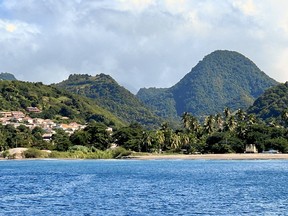
Reviews and recommendations are unbiased and products are independently selected. Postmedia may earn an affiliate commission from purchases made through links on this page.
Article content
On a recent Sunday morning, about a dozen people are gathered at the Aileron trailhead on the slopes of Mount Pelée. Some of us are here to embark on the steep hike to the active volcano’s caldera. Others have come for the panoramic views of Martinique’s highest peak and the unspoiled valleys below.
The Aileron route is the easiest of three trails to the summit of Mount Pelée, which along with its rainforests and the nearby Pitons du Carbet, have recently been named a UNESCO World Heritage site. The designation recognizes not only the volcano’s place in history, but also the wealth of endemic species in the island’s sparsely populated northern region.
Rugged landscapes and a riot of biodiversity are only two of Martinique’s many treasures. Pristine beaches, lively Creole culture, first-rate cuisine and interesting attractions are all part of this under-the-radar destination. So why don’t more Canadians go there?
As part of France, the island enjoys a higher standard of living and better infrastructure than many places in the Caribbean. Most of its yearly visitors — about one million — are from France. Canadians are No. 1 among foreign visitors, but the numbers are very small (about 20,000) compared to other destinations. Most hail from Quebec.
That may be about to change. Until recently, the only non-stop flights from Canada to Martinique originated in Montreal. In December, Air Canada launched a new, once-weekly, flight from Toronto to Fort-de-France, the capital, and tourism officials are working hard to attract visitors from the rest of Canada, says guide Andre La Houssaye.
While Martinique’s beaches are drop-dead gorgeous, they are not lined with all-inclusive resorts. In fact, there is only one all-inclusive resort. Instead, visitors stay in boutique and mid-size hotels or villas.
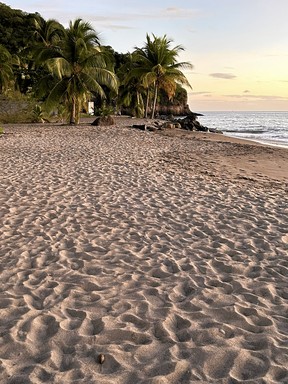
If your perfect vacation involves nothing but beach time, you can certainly do that. But if you’re the type of traveller who likes to fully experience a destination, Martinique is made for that, with activities from nature tourism to adventure to water sports to cultural discovery and more.
Our group does a deeper dive into the island’s biodiversity at Domaine d’Emeraude, a 24-hectare nature park and botanical garden near Morne-Rouge, and Habitation Céron, a 350-year-old sugar-plantation-turned-agritourism attraction in Précheur.
At Domaine d’Emeraude, knowledgeable guide Gladys Guillou-Alphonse leads us on a fascinating stroll along shady, accessible trails, pointing out plants with healing properties, spice and herb bushes — even a cinnamon tree — and the showy blooms Martinique gardens are famous for.
She explains how information gleaned from the Indigenous Kalinago people was passed to enslaved African plantation workers and became part of modern Creole culture. Even today, children learn that having a garden can provide the necessities of life — both food- and health-wise.
Guillou-Alphonse, who once lived in Montreal, says she particularly loves “showing Canadians my island because I was so welcomed (in Canada).”
Later, we enjoy a leisurely lunch at Habitation Céron, where everything on the creative menu is made from ingredients grown on site. The estate is owned by 100 members of the same family who bought it “bit by bit” and are restoring it, also “bit by bit,” says Julie Marraud des Grootes.
Family members play active roles in running the operation. Marraud des Grootes heads up cacao production and is currently cultivating 1,000 plants. After harvest, some of the cacao is processed and sold to chocolate makers. Marraud des Grootes uses the rest to make her own chocolate, which is sold in the gift shop. Visitors can hike the marked trails independently or take tours, including a cacao tour on horseback.
While Fort-de-France is Martinique’s official capital, the former capital of Saint-Pierre is its heartland, says La Houssaye. Once considered the “Petit Paris of the Antilles,” the old town was annihilated when Mount Pelée erupted on May 8, 1902. In an estimated two minutes, a poisonous gas cloud, followed by a firestorm, wiped out the town’s population of about 28,000. Volcanic “bombs” razed buildings to the ground.
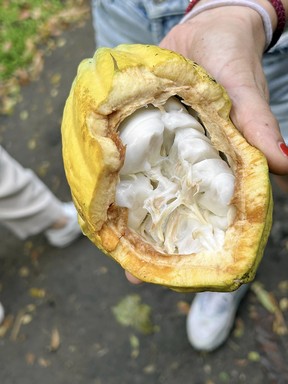
During an electric catamaran cruise with Kata Mambo, we stop at Sainte-Pierre and La Houssaye shows us the extensive ruins, including the grand theatre, the asylum, the old cathedral and the jail, where one prisoner somehow survived the destruction.
Saint-Pierre was rebuilt but never regained its status. The story of the disaster is told at a small museum.
In contrast, Fort-de-France is home to about 75,000 people, about 20 per cent of Martinique’s population. Its busy streets are lined with restaurants and shops, including a Paris favourite, Galeries Lafayette.
We joined Cyclo’comm for an electric pedicab tour of the city’s architectural gems. Among the standouts: the Schoelcher Library with its mosaic facade and Byzantine dome. Built in Paris, the library was displayed at the 1889 World Exhibition, then dismantled and shipped to Martinique, where it was reassembled; Saint-Louis Cathedral with its 57-metre-high spire; the neoclassical courthouse; and seaside Fort Saint-Louis, built in 1638 and still a working naval base.
Also on the waterfront, the Grand Marché is open daily. It’s crammed with vendors selling produce, flowers, spices, crafts, jams and more. Several eateries serve dishes such as grilled fish, chicken colombo, octopus and fritters.
Market vendors also sell Martinican rum, but a better way to discover the spirit is by visiting some of the island’s 15 distilleries. We visited Habitation Clément in François, a historic site that encompasses an old distillery, cellars, a mansion, a tasting room, a shop, a “sensory workshop” and a sculpture garden.
The site was once a sugar plantation, which went bankrupt. In 1887, it was purchased by Homére Clément, one of Martinique’s first Black doctors and a politician, who founded the distillery. Since 1986, it has been owned by the Bernard Hayot group, which has transformed it into a major tourist attraction. Cheers to that!
— Robin Robinson







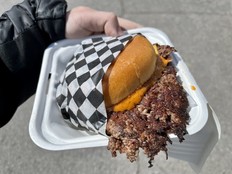
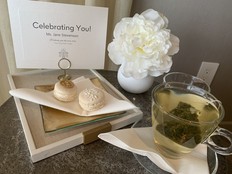

Postmedia is committed to maintaining a lively but civil forum for discussion. Please keep comments relevant and respectful. Comments may take up to an hour to appear on the site. You will receive an email if there is a reply to your comment, an update to a thread you follow or if a user you follow comments. Visit our Community Guidelines for more information.